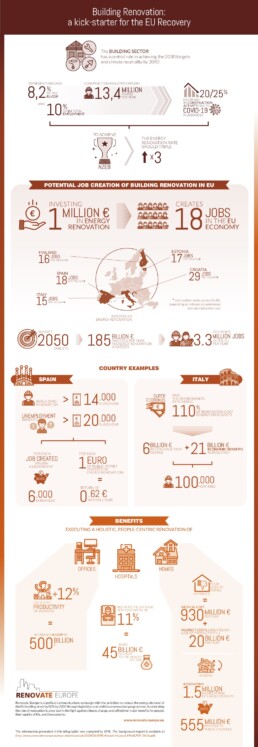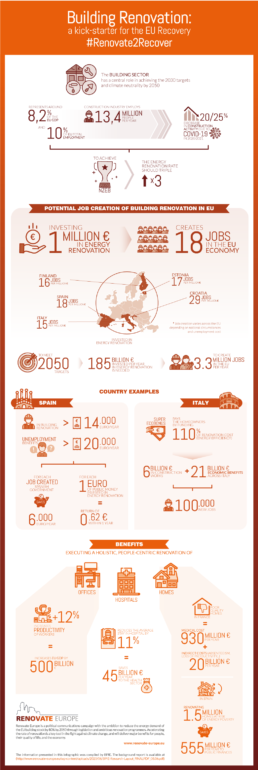Creating a dedicated Renovation Fund in the EU Recovery and Resilience Initiative
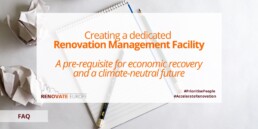
The European Union is planning to assign a vast amount of money to its Recovery and Resilience Initiative, intended to lift the EU economy out of the recession provoked by the global public health pandemic and to put the EU economy firmly on the path to climate neutrality by 2050.
Among the sectors recognised at all political levels as holding the most promise for stimulating the economy, is the energy renovation of our building stock. In general, the building stock in the EU can be described as old, inefficient and in need of renovation. For this reason, the European Commission plans to launch a Renovation Wave via a Strategic Communication and Action Plan in September 2020. For the Renovation Wave to be a success, it will have to be properly resourced. Human, financial, and technological resources will have to be rapidly mobilised on a massive scale.
In advance of this Initiative, the Renovate Europe Campaign (REC) sets out answers to the most often asked questions on building renovation and shows how to mobilise the necessary resources to achieve a transformed, highly energy efficient and decarbonised building stock by 2050.
Why a dedicated Renovation Management Facility?
The availability of financing for climate-related investments, which include energy renovation programmes, has not been high enough in the past to ensure that member states are ambitious enough in rolling out energy renovation programmes. Having a dedicated renovation fund that must be used for the purpose of transforming the building stock will help member states take up the challenge of creating a fully energy efficient and decarbonised building stock by 2050. A dedicated Renovation Management Facility will come with dedicated Technical Assistance, helping Member States to absorb EU funds for building renovation by creating a stronger pipeline of projects – something that would be much easier than with a multitude of funds operating under different eligibility conditions and management features. Furthermore, the economic stimulus potential of energy renovation linked to the multiple environmental and societal benefits that flow from them will, in times of economic recovery, be a more attractive investment option for member states. Knowing that there is dedicated financing available will make it easier for them to prioritise energy renovation in their plans.
Who should manage the Renovation Management Facility?
The institution best placed to manage such a renovation fund is the European Investment Bank (EIB). It is undergoing a transformation to become the climate bank of Europe and it has built up considerable knowledge and skill in managing energy efficiency financing in the last decade. Creating a multi-disciplinary and multi- lingual team within the bank to take on the task of blending EU sources of financing onto a single fund and overseeing its distribution to partner banks, regional and local authorities, and institutions in all EU member states will be necessary, but the EIB has the capacity and the experience to undertake this task in a short timeframe.
An essential element of the task will be to provide technical and project development assistance to member states and to local authorities. Again the EIB has extensive experience of doing just this as it has been managing numerous advisory programmes, such as fi-compass, ELENA, JASPERS and URBIS, aimed that supporting national, regional/local authorities in implementing their sustainable action plans.
Why are buildings so important to economic recovery?
The act of building or the act of renovating is a labour-intensive activity. It is therefore a great source of employment and of quality jobs. This makes construction activity essential to our economies. The Renovate Europe Campaign recently published a study, based on research by the BPIE, that showed that on average 18 jobs are created in the EU for every €1m invested in energy renovation. In addition, buildings are fixed assets tied to their location and present in all corners of the EU, thus energy renovation programmes provide local jobs for local businesses (mostly SMEs) boosting economies at all scales. Knowing that the technologies, equipment and approaches needed to deeply energy renovate our building stock are already on the market means that we can, with confidence, require that the renovation wave is initiated without delay to assist in the post-COVID-19 economic recovery.
How important is building renovation to the daily life of EU citizens?
Because we spend more than 90% of our time inside buildings, the quality of our buildings and of their indoor environment has a big impact on our daily lives. This is most starkly illustrated when we look at the statistics
about energy poverty. A large proportion of households in energy poverty are living in buildings that are in poor condition and the occupants are more likely to suffer from chronic illnesses as a result. Comprehensive energy renovation is the sustainable answer to energy poverty.
The Renovate Europe Campaign recently published a study, based on research by the BPIE, that shows that the health benefits of undertaking quality renovations of homes in France would improve people’s health to such an extent that the Health Service could save around €930m per year. Furthermore, it found that if you take account of the increased productivity that results from lower levels of absenteeism and higher worker productivity, the boost to the French economy could be as high as €20bn per year.
In addition, buildings are the biggest investment (if you are an owner) or the highest cost (if you are a tenant) that we face in our daily lives. Ensuring that they are of high quality and resilient against the effects of climate change is therefore crucially important.
Finally, buildings express our cultural identity. We should not forget that buildings shape the living environment in our cities as well as in towns and villages. Well-designed, comprehensive energy renovation programmes can contribute to upgrading districts and forming cosy, cherished neighbourhoods.
Why is a renovated building stock a prerequisite to achieving the EU 2050 climate goals? What level of commitment is needed?
In the operational phase, buildings consume 40% of primary energy and emit 36% of energy-related CO2 emissions. The energy demand of the building stock in the EU must be reduced by 80% by 2050, by a combination of technologies that address energy losses in the fabric of buildings coupled with highly energy efficient equipment and controls within the building. The remaining 20% demand must be supplied by zero- carbon renewable energy sources. Unless the emissions from our buildings are reduced to zero, we cannot succeed to achieving the EU’s long-term objective of a climate-neutral economy by 2050.
Going further and including digitalisation to ensure demand response and a connection to energy grids permits buildings to play a fuller role in energy system integration and balancing of energy flows in our energy systems. To properly valorise the investments in renovation in terms of energy saving and carbon emission reductions, the CEN EPBD set of standards need to be widely adopted to make investment across Europe comparable. This integrated approach to renovation is being used today in pilot and demonstration projects but must become the norm within a short period of time.
How much money has the EU already invested in energy renovation?
The EU has invested considerable funding over the years in energy renovation. Some of the money has been used to provide technical assistance to member states and to local authorities, some has been in the form of guarantee funding to underwrite and leverage investments in the sector and some has been channelled to research and innovation.
According to a recent report by the European Court of Auditors, the EU co-funding for energy efficiency in buildings totalled just €14bn from Cohesion Funds in the 2014-2020 period. This is corroborated by a recent JRC study that reports that Member States spent €15bn annually on renovations from their own pockets, mostly in subsidies (60% of total investments). This means that current public investments fall well short of the level of funding needed from the EU to stimulate the renovation of our building stock!
How much and what kind of money is required to achieve the deep renovation of the building stock in the EU?
Finding the needed financial resources to achieve the transformation of the building stock in the EU is an enduring challenge. We know that the annual turnover in the construction sector (all activities) is in the region of €1,400 billion and that the turnover dedicated to renovation and maintenance activities is in the region of €370 billion. However, as the rate and depth of renovation increases in the future, the financial needs will grow and the European Commission recently estimated (cf. page 17) that there is a €185 billion annual investment gap for renovation of buildings. The Renovate Europe Campaign calls for that gap to be filled by the development of a dedicated Renovation Management Facility or Fund, within the policies that are being developed to ensure economic recovery and to build a resilient, climate-neutral economy in the EU.
It is clear to all stakeholders that this amount of money cannot be expected to be provided solely from public financing. It will have to be a blend of public and private financing that is sourced via various mechanisms.
Turning to how the money should be structured, we can say that there are at least three types of financing needed:
– Grants or pure “give-away” money that could be in the region of 30% of the total money being made available and that should only be channelled to the most vulnerable in society who cannot afford to invest in their properties and who will benefit most from the upgrading of their buildings (i.e. energy poor households) – Guarantee funds that cover the perceived risk associated with energy efficiency investments. This can best be provided by public financing to leverage or “crowd-in” private money
– Preferential loans provided through high street banks to building owners and developers. These loans have conditions attached that mean the preferential conditions only apply when the works to the building actually achieve (or exceed) the promised energy efficiency improvements. Having these loans widely available can encourage homeowners to more readily invest in their properties.
It is worth emphasising that investments leveraged by EU and member state funding will improve economic activities ending up in increased tax incomes and reduced costs for unemployment support. Furthermore, the European Commission stated in the inception impact assessment on the EU strategy on adaptation to climate change that exposing the present EU economy to global warming of 3°C would result in an additional annual loss of at least €170 billion (1.36% of GDP). Therefore, the balance for the gross economy will be lower than the required budget.
What is the Renovation Wave, and why is it important?
The Renovation Wave is an initiative of the European Commission that was included in the European Green Deal. It will take the form of a strategic communication that will set out a vision for the building stock in the EU, outlining the barriers and drivers of renovation, and it will be accompanied by an action plan that will demonstrate how the financial, human and other resources needed to make the initiative a success can be mobilised. The Communication and Action Plan are expected to be published in late September 2020. The Renovate Europe Campaign has set out its view on the ten elements that must be included to make the Renovation Wave a success.
Given the general lack of ambition seen in the national Long-Term Renovation Strategies, the Renovation Wave of the European Commission should spur and require more action and ambition from the member states. Most of all it should be the spark that finally pushes the energy renovation rate in the EU rapidly upwards towards the needed 3% per annum rate and that ensures all renovations achieve the full energy-saving potential tied up in our buildings. It must set the scene for how to succeed in creating a Renovation Wave in the EU that will put us on the pathway to a decarbonised stock by 2050.
Why are buildings today wasting so much energy (and money) in the EU?
A recent study by the BPIE found that 97% of the building stock in the EU needs to be upgraded as only 3% of the stock has an energy performance level equivalent to Class A. This arises mainly because about 75% of the stock was built at a time before member states introduced energy performance requirements in their building regulations.
We must reduce the energy demand of the building stock in the EU by 80% by 2050. To achieve this goal, we need holistic energy renovation programmes developed within a coherent policy framework that encourages stakeholder involvement and that results in projects that combine technologies to reduce energy losses with highly energy efficient equipment and building control systems. The residual 20% demand can then be more easily and economically supplied via renewable, decarbonised energy sources. This will, in parallel, reduce Europe’s dependency on energy imports and energy bills for consumers will reduce dramatically, boosting disposal income for families and businesses.
What is the current rate and depth of energy renovation in the EU, and is it adequate?
An important recent study undertaken by Navigant for the European Commission shows that the average energy renovation rate in the EU is 1% per annum. By energy renovation, the study means any renovation works that deliver a 3% or greater energy saving. If we look only at the energy renovations that deliver 60% or more savings (and this is the level of ambition that is needed), the rate is just 0.14% per year. The same study calculates that the average energy saving for energy renovation projects is just 9%. This is extremely low and significantly below the amount of savings needed to ensure that the building stock will be highly energy efficient and decarbonised by 2050. It is also very much below the level of savings that current building technologies, equipment and approaches to renovation can deliver. From this we can see that the current rate and ambition of energy renovation in the EU is not nearly adequate if we are to meet the long-term objective of the EU to be the first climate-neutral economic region in the world.
End
Download the FAQ here
Energy Efficiency and Economic Recovery: Lessons from the Great Recession in the EU and US
30th June 2020 (16 :00-17:00 CEST)
The American Recovery and Reinvestment Act (ARRA) and the European Economic Recovery Plan were two massive stimulus packages passed in 2009 to counter the effects of the economic slowdown.
Against this background, and on the light of the current debates, the Renovate Europe Campaign joined forces with the Alliance to save Energy (ASE) to organise a very timely event, whose aim is to dive into the past to discover which role energy efficiency can play in accelerating the economic recovery. Topics included the role of energy efficiency in the Great Recession’s American Recovery and Reinvestment Act (ARRA) and the European Economic Recovery Plan, the ongoing impact of these packages on our sector today, and how these plans can inform decisions on upcoming stimulus proposals and recovery plans.
Speakers included:
- Pernille Weiss,Member, European Parliament (EPP)
- Peter Sweatman,CEO, Climate Strategy & Partners
- Yamina Saheb,Senior Climate and Energy Policy Analyst, OpenEXP
- Stacey Paradis, Executive Director, Midwest Energy Efficiency Alliance (MEEA)
- Timothy Unruh, Executive Director, National Association of Energy Service Companies (NAESCO)
- Lisa Jacobson,President, Business Council for Sustainable Energy (BCSE)
The session featured remarks from Clay Nesler, Interim President of the Alliance, and Adrian Joyce, Renovate Europe Campaign Director.
To watch the session, click here
For more information about EE Global Webinar Series, visit here
Beneficial Undercurrents for the Renovation Wave
By Adrian Joyce, Director of the Renovate Europe Campaign

The Renovate Europe Campaign (REC) impatiently awaits the text of the European Commission Communication and Action Plan on creating a Renovation Wave in the EU. We are encouraged that the huge energy saving potential of the building stock in the EU is at last being mentioned at the highest political levels across the EU and in its Member States. Still, we are concerned that turning words into actions will still elude our national leaders and so we asked the Buildings Performance Institute Europe (BPIE) to undertake a Study on the positive economic and other impacts that creating and implementing ambitious building renovation programmes can bring. Not surprisingly, they are varied and significant!
For the plans of the EU Member States and of the EU itself to succeed, they should be based on sound argumentation and on solid evidence that the effort will be worthwhile for all. Member States have tended to shy away from taking action on buildings, as to do so at the scale that is needed, will impact the daily lives of millions of EU citizens. Nevertheless, the realisation has dawned on political leaders that without action on buildings, the future looks bleak and, in particular, the ambition to adorn the EU with the first climate-neutral economy in the world will be just a pipe-dream.
To change mindsets, we constantly seek to present convincing, well-researched arguments as to why the effort is worthwhile. This approach has been the “red thread” of the REC since its inception in 2011, and in planning for the Renovation Wave, we have reinforced our approach in partnership with the BPIE. The 40 partners of the REC hold the view that it will be of crucial importance to ensure that the early implementation stages of the Renovation Wave Action Plan are successful. We see this as THE opportunity to finally transform the lives of all our citizens, creating a highly energy efficient, decarbonised and healthy building stock.
So, what are the benefits that will flow from taking ambitious action on energy renovation of the building stock in the EU? From a detailed scan of 35 recent reports on the jobs and other benefits of energy renovation, the BPIE has found:
On jobs and economic impact:
- For every €1 million invested in energy renovation of buildings, an average of 18 jobs are created in the EU. These are local, long-term jobs that will stimulate economic activity across the EU
- The number of jobs created per €1 million invested varies across the EU depending on national circumstances and employment cost. The Study reports that those numbers, for selected countries that have recently researched the issue, are: Croatia, 29; Estonia, 17; Finland, 16; Italy, 15 and Spain, 18
- At national level, the Study found that it costs an average of €14,000 to create a job in construction in Spain, whilst in the same country it costs €20,000 to support an unemployed worker. In addition, for each €1 of public money spent on energy renovation, the Spanish government gets €0.62 in return within one year, mainly via taxation.
On macro-economic benefits by building segment:
- Holistic, energy efficient renovation of office buildings increases productivity by about 12% leading to a potential benefit of about €500 billion to the economy per year
- Well-designed and executed energy renovation of hospitals reduces the average patient stay by about 11%, producing potential savings of about €45 billion per year to the healthcare sector
- For homes, it was found that in France medical costs of about €930 million per year are linked to poor quality housing. If we include the indirect consequences of such ill-health (absenteeism, lower productivity etc.), poor quality housing could be costing the French economy as much as €20 billion per year.
The clear message that comes from this Study is that investing in the energy renovation of our building stock is a very rewarding choice. It brings personal benefits, societal benefits, and economic benefits.
The REC is convinced that it is now up to each Member State of the EU to include energy renovation of our building stock in their Recovery and Resilience Plans so that the promised renovation wave can be successfully rolled out with many undercurrents of multiple benefits for all.

End
Building Renovation: a kick-starter for the EU economy
 The BPIE has carried out this Study at the request of the Renovate Europe Campaign at a time when the topic of energy renovation seems to be on everyone’s lips. The request was made following the realisation that an overview of recent research on the job creation and macro-economic benefits of energy renovation in the EU has not been compiled in almost 6 years. The findings are encouraging, in the sense that much research has taken place at all levels – national level, European level and global level – and that the stimulus effect of investing in energy renovation is great.
The BPIE has carried out this Study at the request of the Renovate Europe Campaign at a time when the topic of energy renovation seems to be on everyone’s lips. The request was made following the realisation that an overview of recent research on the job creation and macro-economic benefits of energy renovation in the EU has not been compiled in almost 6 years. The findings are encouraging, in the sense that much research has taken place at all levels – national level, European level and global level – and that the stimulus effect of investing in energy renovation is great.
This makes this short Study a valuable contribution to the debate on how and where to spend the large funds that are being mobilised to help the EU and its Member States recover from the economic impact of tackling the COVID-19 pandemic.
Key Findings
In its review of 35 research reports, the BPIE highlights the following main findings:
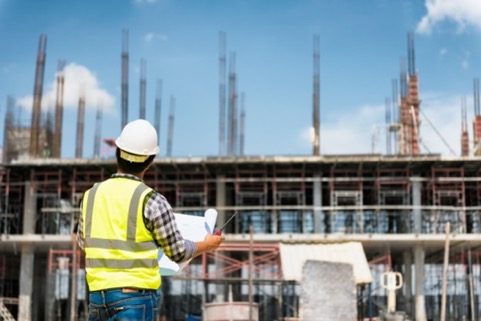
On jobs and economic impact:
- For every €1 million invested in energy renovation of buildings, an average of 18 jobs are created in the EU. These are local, long-term jobs that will stimulate economic activity across the EU
- The number of jobs created per €1 million invested varies across the EU depending on national circumstances and employment cost. The Study reports that those numbers are: Croatia, 29; Estonia, 17; Finland, 16; Italy, 15 and Spain, 18
- At national level, the Study found that it costs an average of €14,000 to create a job in construction in Spain, whilst in the same country it costs €20,000 to support an unemployed worker. In addition, for each €1 of public money spent on energy renovation, the Spanish government gets €0.62 in return within one year, mainly via taxation.
On macro-economic benefits by building segment:
- Holistic, energy efficient renovation of office buildings increases productivity by about 12% leading to a potential benefit of about €500 billion to the economy per year
- Well-designed and executed energy renovation of hospitals reduces the average patient stay by about 11%, producing potential savings of about €45 billion per year to the healthcare sector
- For homes, it was found that in France medical costs of about €930 million per year are linked to poor quality housing. If we include the indirect consequences of such ill-health (absenteeism, lower productivity etc.), poor quality housing could be costing the French economy as much as €20 billion per year.
The clear message that comes from this Study is that investing in the energy renovation of our building stock is a very rewarding choice. It brings personal benefits, societal benefits and economic benefits. It is now up to each Member State of the EU to include energy renovation of our building stock in their Recovery and Resilience Plans so that the promised Renovation Wave can be successfully rolled out to the benefit of all.
Buildings and Recovery Measures: the role of energy renovations in supporting European recovery
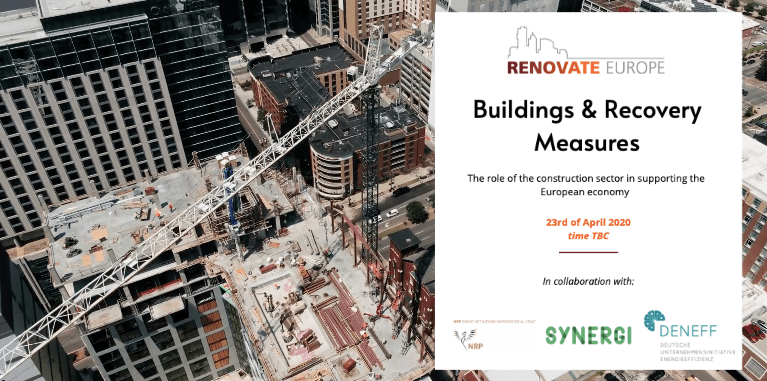
23rd April 2020 (09:30-10:30 CEST)
In collaboration with REC National Partners SYNERGI, DENEFF and NRP, three emerging approaches to be deployed respectively in Denmark, Germany and The Netherlands, will demonstrate the importance and potential behind deep energy renovation of buildings and the role it can play in European economic recovery in the period ahead. The goal of the discussion is to better understand good practices at national level thus helping to prepare, in advance, the actions that can be gradually put in place once the lock-downs measures will be lifted, and that will ultimately feed into a responsive Renovation Wave Initiative.
Agenda :
Introduction
Adrian Joyce, Director of the Renovate Europe Campaign
Ensuring that energy renovation programmes are the heart of the economic recovery – National examples:
- Advance Planning in Denmark by Katrine Bjerre Milling Eriksen, of SYNERGI
- Preparing for the renovation wave in Germany by Henning Ellermann, of DENEFF
- The Dutch approach to economic recovery by Albert de Vries, of NRP
Q&A Session
(moderated by Eva Brardinelli, REC Campaign Office)
Closing Remarks
Adrian Joyce, Director of the Renovate Europe Campaign
Click here to access the PowerPoint presentation
https://youtu.be/lKIiax2jN1A





